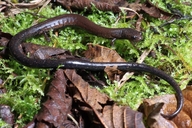|
Oedipina poelzi Brame, 1963
Quarry Worm Salamander Subgenus: Oedipina | family: Plethodontidae subfamily: Hemidactyliinae genus: Oedipina |
 © 2024 Noah M. Morales (1 of 3) |
|
|
|
Description Oedipina poelzi resembles O. collaris but has a broader, blunt snout, wide head, eyes that are placed more closely together, and slightly longer premaxillary and maxillary teeth. Oedipina poelzi is unique among other members of the genus in that it has relatively long limbs and larger syndactylous feet (Brame 1963). In life, Oedipina poelzi has a dark brown dorsum and black venter, which are separated by a long lateral stripe that is creamy to silvery in coloration. The tail and legs are dark with dark brown splotches. White chromatophores punctuate the lateral sides of the tail and can be found along the venter. This species has a pale spot above the postiliac gland. In alcohol, the brown dorsum and light lateral stripes are absent, but the white chromatophores can be seen in present. The iris is black (Brame 1963; Savage 2002). The brown color of the dorsum is variable in Oedipina poelzi and ranges from a lighter orange-brown to dark brown. Yellowish or brown bands and patterning on the head and tail may be present (Brame 1963). This species is sexually dimorphic, as the males are smaller in size and have a mental gland, long premaxillary teeth, papillate venters, and nasolabial protuberances (Savage 2002). Distribution and Habitat Country distribution from AmphibiaWeb's database: Costa Rica
Life History, Abundance, Activity, and Special Behaviors When threatened, members of this species may remain motionless, roll into a ball, or flip over entirely (Savage 2002). Trends and Threats Possible reasons for amphibian decline General habitat alteration and loss Comments The species epithat, poelzi, was chosen after the German herpetologist Friedrich Pölz. Salamanders of this species may exhibit molecular sequence divergences of up to 13.7% and 4% in the genes cyt b and 16s, respectively (García-París and Wake 2000). In a recent study naming new species within the genus, Oedipina grandis and O. leptopoda form a clade sister to O. collaris. The clade uniting these three taxa is recovered as the sister group to O. poelzi (McCranie et al. 2008).
References
Brame, A. H., Jr. (1963). “A new Costa Rican salamander (genus Oedipina) with a re-examination of O. collaris and O. serpens.” Los Angeles County Museum Contributions in Science 65, 1-12. García-París, M., and Wake, D. B. (2000). “Molecular phylogenetic analysis of relationships of the tropical salamander genera Oedipina and Nototriton, with descriptions of a new genus and three new species.” Copeia 2000, 42-70. McCranie, J. R., Vieites, D. R., and Wake, D. B. (2008). ''Description of a new divergent lineage and three new species of Honduran salamanders of the genus Oedipina (Caudata, Plethodontidae).'' Zootaxa, 1930, 1-17. Savage, J. M. (2002). The Amphibians and Reptiles of Costa Rica:a herpetofauna between two continents, between two seas. University of Chicago Press, Chicago, Illinois, USA and London. Stuart, S., Hoffmann, M., Chanson, J., Cox, N., Berridge, R., Ramani, P., Young, B. (eds) (2008). Threatened Amphibians of the World. Lynx Edicions, IUCN, and Conservation International, Barcelona, Spain; Gland, Switzerland; and Arlington, Virginia, USA. Wake, D. B. (1987). “Radiation of salamanders in Middle American cloud forests.” Annals of the Missouri Botanical Garden 74(2), 242-264. Originally submitted by: Adam D. Marsh (first posted 2009-11-04) Edited by: Ann T. Chang (2019-03-06) Species Account Citation: AmphibiaWeb 2019 Oedipina poelzi: Quarry Worm Salamander <https://amphibiaweb.org/species/4112> University of California, Berkeley, CA, USA. Accessed Nov 25, 2024.
Feedback or comments about this page.
Citation: AmphibiaWeb. 2024. <https://amphibiaweb.org> University of California, Berkeley, CA, USA. Accessed 25 Nov 2024. AmphibiaWeb's policy on data use. |




 Raffaëlli Account
Raffaëlli Account Map of Life
Map of Life